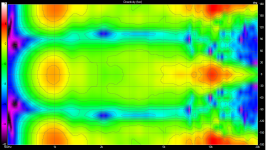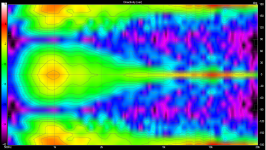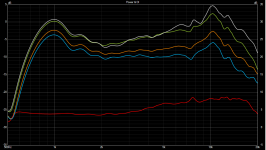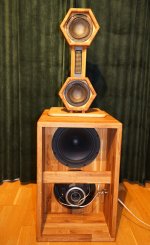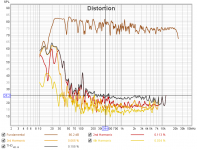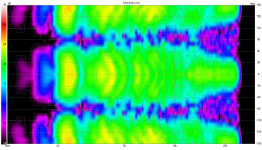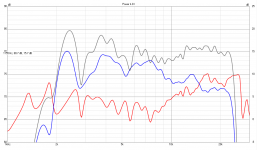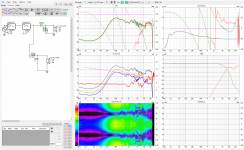How did you measure? Did you turn the speaker or the AMT around to measure the back? What distance did you measure? Did you dampen the back when you measured it closed? And please don't be annoyed by that question even if others and I already asked that.
This is my second OB speaker build, first was made about 10 years ago but then with horn ribbon tweeter Fountek NeoCD3.5H and Scanspeak 15M/4624G00 mids In MTM configuration (same as one older version of Juhazi Aino). I use same DSP, DAC and amplifiers with current build. I begin from passive filters, then used analog dipole cancellation correction on bass and last version with NeoCD3.5H was made using EQ APO and linear phase filters and corrections made with rePhase..
All measurements here are made from 1 m, and speaker is more than 1 m away from all objects in the room. Measurements are made with gated window, in first post 2,5 ms, in all others 4,5 ms to get some part of mid range presented. In post AMT Pro-4 as OB tweeter same measurements as in first post are converted to 4,5 ms gating. Difference is minor in tweeter range..
I turn speaker, microphone was not moved.
In closed version measurement AMTPRO4 back was closed with producer supplied felt, 2 identical parts with thickness of about 7 mm, one on other. Dimensions of felt parts are made so that they exactly fit between rear magnets and close all rear opening tightly. How tightly can be seen from closed version polar plot measurement.
I get nearly same ATMPRO4 measurements as in German forum link you posted. But I some how like integrity of higher mid range and high range achieved with It. Filter is on 1 kHz and it is very different than NeoCD3.5H integration with mids with 2,5 kHz filter, partly because NeoCD3.5H is not OB but mids where.
I am also relatively sure that dip at 4.5 kHz in polar plot under angle 30-60 degrees is not possible to hear, at least I did not hear.
But if technically is possible to avoid this, I am interested to find out and implement.
Member
Joined 2003
Just want to contribute my own measurements. I am using AMTPRO-4 in a dipole arrangement, and have a complete set of measurements at 15deg increments with no felt applied to the back side. Photo below of the speaker baffle the AMT is mounted on.
The AMTPRO is a capable tweeter, but unfortunately due to the size and shape it has a confusing directivity pattern - very wide horizontal and very narrow vertical. I think it gets the "pro" name simply because the directivity dictates that the ideal listening distance is further away than what would be present in most home living rooms. More of a "sit and listen" type of speaker at home, and in my space I am able to keep 3m+ distance from speaker to couch, but the top end is still like a laser beam. The only correction to this is to add another tweeter crossed at 6kHz or so. In my case, I am using some DSP to shape the response and keep some of the on-axis lift in the response in order to partially compensate for the directivity.
The good news is that the wide horizontal pattern contributes to a decent overall in-room response and power response, and it can sound very good, but misses some of that top end "air" that you get from smaller tweeters. I have a crossover around 1.5kHz to a Peerless 830883, and some DSP EQ applied to fine tune to satisfaction.
The AMTPRO is a capable tweeter, but unfortunately due to the size and shape it has a confusing directivity pattern - very wide horizontal and very narrow vertical. I think it gets the "pro" name simply because the directivity dictates that the ideal listening distance is further away than what would be present in most home living rooms. More of a "sit and listen" type of speaker at home, and in my space I am able to keep 3m+ distance from speaker to couch, but the top end is still like a laser beam. The only correction to this is to add another tweeter crossed at 6kHz or so. In my case, I am using some DSP to shape the response and keep some of the on-axis lift in the response in order to partially compensate for the directivity.
The good news is that the wide horizontal pattern contributes to a decent overall in-room response and power response, and it can sound very good, but misses some of that top end "air" that you get from smaller tweeters. I have a crossover around 1.5kHz to a Peerless 830883, and some DSP EQ applied to fine tune to satisfaction.
Attachments
I had noticed same, top end is not same easy and open as has real ribbon tweeters as NeoCD3.5H.but misses some of that top end "air" that you get from smaller tweeters.
This is how full speaker looks. Bass section is also H-frame with dipole cancellation compensation.
Preliminary THD measurements from listening position also, actual level is higher, little below 90dB, I had not calibrated the SPL level.
Attachments
This is how full speaker looks. Bass section is also H-frame with dipole cancellation compensation.
The woofers aren't compensated, they are wired parallel, so neither the impulse (they go in the same direction) nor asymmetric in/out behaviour (only works on isobar coupling (which they aren't) of two 180° drivers).
Preliminary THD measurements from listening position also, actual level is higher, little below 90dB, I had not calibrated the SPL level.
That looks very good. What's the max spl?
Compensation is made in electronics, actually in anolg to win about 20 dB headroom in digital domain.
I had not tested max SPL, not had need for that.
I had not tested max SPL, not had need for that.
If you define for example speaker maximum SPL level as level where speaker distortions are 5%, then you see it on previous image. THD close to 20 Hz is there about 5%. Actual bass level there is about 90dB
No, that's not right. In the bass, the ear is so much less sensitive to distortion, the distortion can be much higher there without it being noticable. And that measurement does not answer the question since the distortion does not rise linear at all, there will be ranges where it will be higher and others hardly increase. Though, you don't have to measure the max level but an increase of 6 or 10dB shows a very clear tendencies and allow a good estimate when comparing the measurements.
Actually when I increase SPL level THD will fall, this is because mostly THD in last measurement is defined by room noise, measurement is made from listening position. I cannot increase SPL level very much as bass amplifier will clip, because +20 dB compensation EQ on low end.
Last edited:
I get small open back version of ATM named as RT13, by label produced at Plat Audio. Overall outside measurements 40x40 mm, radiation opening on both sides is 20x20 mm.
Plan is to use it as super tweeter for AMTPRO4. Only as my DAC had 3 stereo channels, I must use passive filters.
On measurements peak on 16260 Hz is EQ-ed down by 5.3 dB.
Plan is to use it as super tweeter for AMTPRO4. Only as my DAC had 3 stereo channels, I must use passive filters.
On measurements peak on 16260 Hz is EQ-ed down by 5.3 dB.
Attachments
- Home
- Loudspeakers
- Multi-Way
- AMT Pro-4 as OB tweeter

